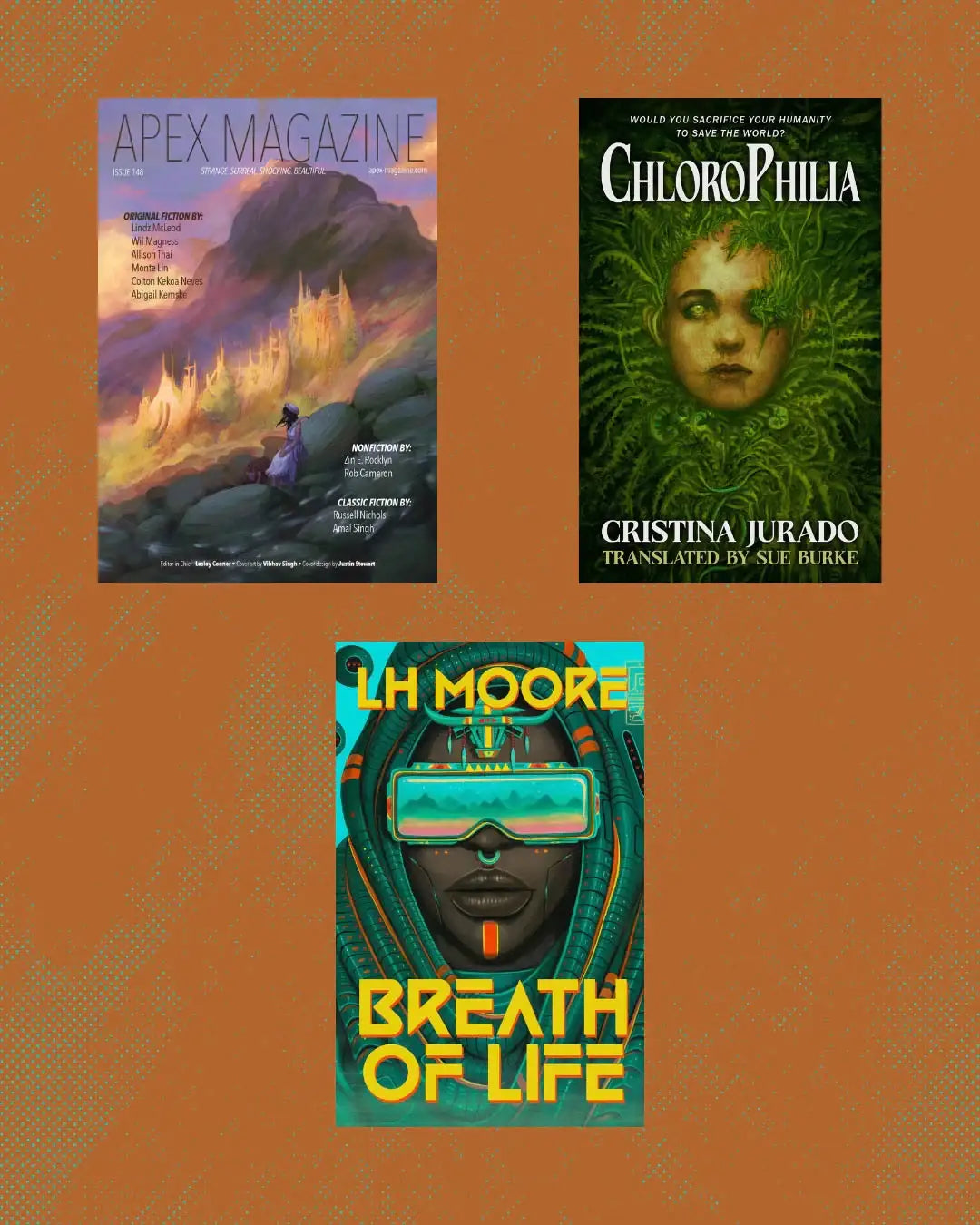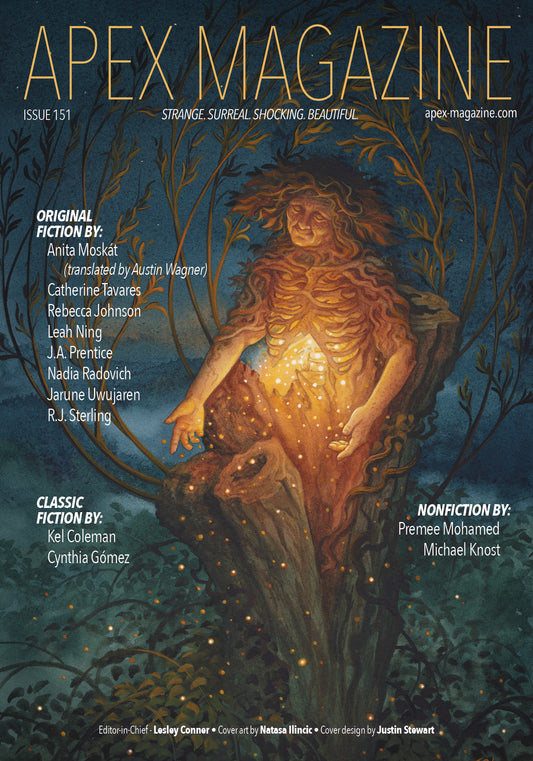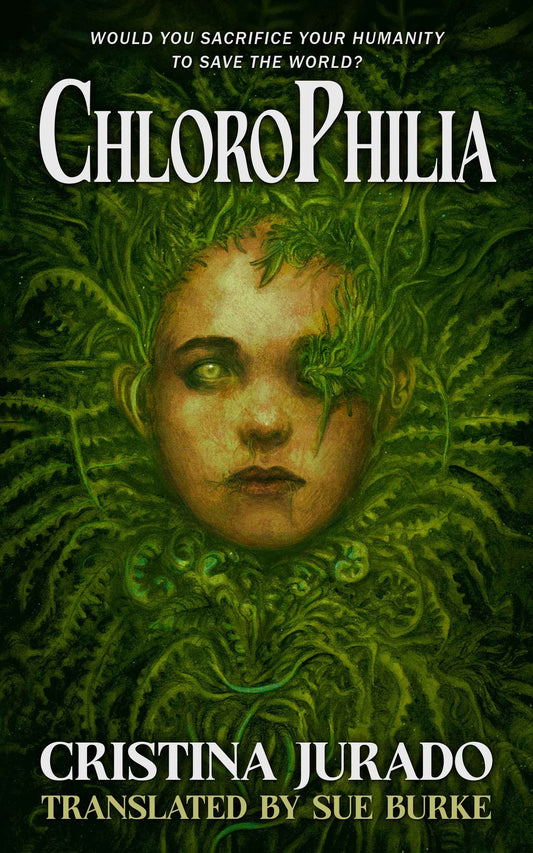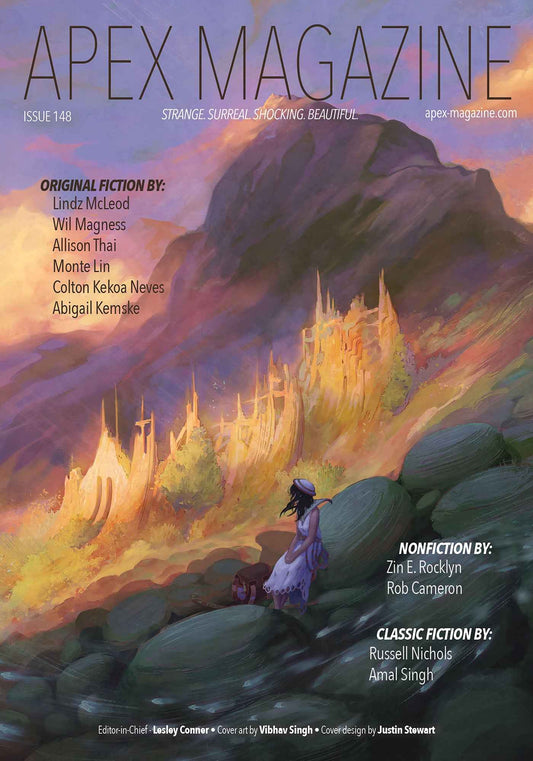
Welcome to another Words for Thought! The five stories discussed this time around all deal with the idea of being seen, whose stories get told and how, and who has access to resources and power. As always, there may be some spoilers ahead, so proceed with caution!
“There are three children jumping over a can outside a bodega” by Mark Galarrita, published in Nightmare Magazine, is a highly effective story that packs a lot into less than two thousand words. A man seeking “authenticity” in order to boost his TikTok following turns his camera on three Brown boys playing outside a bodega. He doesn’t have or seek their permission; as far as he’s concerned they are subject matter for his use, not people.
But his search for truth is not enough. His TikTok fanbase grows, all four hundred thousand followers across the globe, hungry, no, starving, for thereal realof the American city today.
Social media consumption meets actual consumption as old gods show up to let it be known that they will be the ones doing the eating, thank you very much. The story neatly tackles voyeurism, in particular social media and its tendency to turn people into products, while also shining a light on the fact that it isn’t always the people whose lives are being offered up who are framing and telling their own stories. The question of who is behind the camera, and therefore whose perspective ultimately gets seen, heard, shared, and imbued with an air of authority, goes hand in hand with the notion of “authenticity” and who gets to define what that means. Overall, the story is an excellent exploration of horrors both cosmic and human.
“My Containment” by Shannon Scott, also published in Nightmare Magazine, offers up a variation on the animal wife trope as an American tourist encounters a river spirit in the Old Country and decides it’s his right to kidnap her and bring her home.
I shook my head. I had to stay in the water. I’m not a mermaid, I have legs, but five steps away from the river and I will dry up and blow away.
As with Galarrita’s story, Scott’s also deals with the idea of person-as-possession, an object to be consumed and used. The tourist dictates the river spirit’s story, telling her she should be happy and grateful for his love, framing what they mean to each other according to his desires alone. Scott adds an extra layer of depth to the story with the river spirits own desires as dangerous, slowly revealing the backstory of her sister’s death. The story is evocatively written, and full of rich, sensory detail that makes it feel immersive. Very nicely done!
“Blackjack” by Veronica Schanoes, published at Reactor, is a story that is, among other things, about the way our perceptions of ourselves and those around us change over time. It’s also a story about family, and how love persists even through imperfect relationships and the inability to see eye-to-eye.
Josie is raising her two grandchildren after her daughter’s suicide. While her daughter was alive, their relationship was troubled; Myra never got over her father leaving, and blamed Josie for it, even though Harry wasn’t a particularly good husband or father.
Harry, he was so handsome. Even after I knew he was no good, I couldn’t keep my hands off him. He had thick, dark, curly hair and sparkling dark eyes, and a knowing, cynical smile that just made me weak. A nice sharp jawline. Phil, now, he never really set my blood pounding like that, but on the other hand, he’s never raised his voice, either, to me or to Myra, not even to his own boys. Harry had a mean streak. Myra got that from him.
During a trip to Vegas, Josie encounters Harry’s ghost. He’s trapped in a kind of limbo, but if Josie agrees to play blackjack against Lilith, she can win his soul back. She agrees, for Myra’s sake, and ultimately works things out so that Harry will have to face the consequences of his actions and the impact they had on the daughter he left behind.
Schanoes does a lovely job of unpacking complicated family relationships and examining different kinds of love—Josie’s love for Harry, her love for her second husband, Phil, and the fraught love between Myra and her parents. The story shows the evolution of relationships over time, and how Josie herself is a different person now, able to look back at her younger self and see things more clearly, accepting them as part of herself, but not tied to who she was then, able to heal and move on.
“Those Who Smuggle Themselves into Slivermoon” by Varsha Dinesh, published in Strange Horizons, focuses on literal and figurative invisibility, and a different kind of consumer culture—one where equal opportunity and access to wealth is dangled as a false promise and existence itself becomes a series of micro transactions designed to keep the rich rich and the poor poor.
Saki is a ghost on Slivermoon. He and his lover, Anjun, are trying to make a better life for themselves, but to do so, they have to leave their bodies behind, then earn them back through work.
Saki hadn’t always dreamed of going to slivermoon. It was Anjun who put the idea into his head. Anjun, who worked three night shifts a week at the same office, pressing the same buttons that taught a robot the meaning of violence. Anjun, who drove a third-hand motorbike and ate the same lunch of rice, lentils, and bramble berry pickle every afternoon. Anjun, who got neither cats nor women but men—always men, he told Saki secretly one day.Men who look like you.
The story is beautifully-written and heartbreaking as it looks at access to opportunity and even basic needs. Within the world of the story, having a physical body and having control over its appearance is a privilege reserved for the wealthy, paralleling real-world issues around disability, gender, and access. The story also reflects on the way AI and other technologies inherit racism from their designers, among other themes it explores, all while keeping the main character and his personal arc at the story’s heart. Saki's situation, the dream he’s trying to accomplish of having a better life, is contrasted starkly with the reality of the system. The situation is further complicated by finding out that Anjun isn’t the person he thought, and that perhaps never truly saw Saki at all—seeing not a person, but only a means to an end.
The story packs in quite a bit, but it all feels perfectly balanced. No one thread outweighs the others, and the world and character building all get their equal share of attention too. It’s not an easy feat, but Dinseh pulls it off beautifully.
“Patience is the Virtue” by Aimee Ogden, published in Weird Horror, is a brief and creepy story that, like Scott’s, centers on a woman being treated as a possession by a man who claims to love her. In this case, Caroline is made into a living doll by her husband—gifted immortality from his perspective, and from hers, trapped eternally in a new form she does not want.
Her skin now is starched silk, dyed to a healthy pinkish complexion and painstakingly spotted with the same constellations of freckles that marked her in life. To lend depth to her skeletal form, Howard has hand-sewn silk bags to exacting proportion and stuffed them with sawdust. Her waist draws in narrower than it did in life, Howard sometimes points out, in keeping with the new fashion, now that she need not manage the difficulties of digestive organs.
Once again, like Scott’s story, Caroline in Ogden’s story is expected to be grateful for having control of her life taken away from her. Howard does not see her as a person, but as his possession, hers to do with as he pleases, and also a means of proving his own scientific genius. Ogden does a wonderful job capturing a claustrophobic feel, and putting readers into Caroline’s position as she is moved through life, physically present but unseen by those around her.











